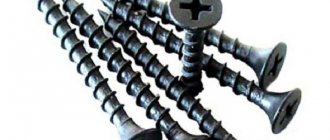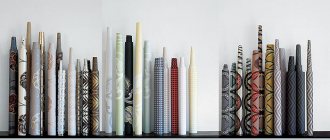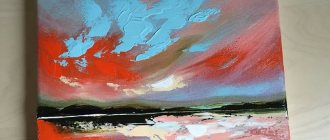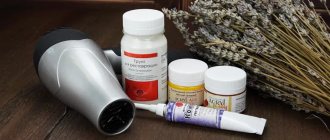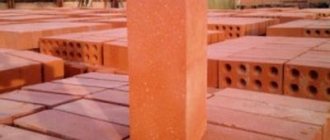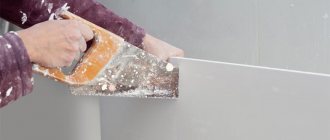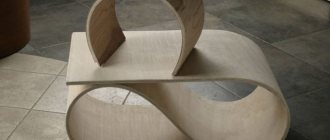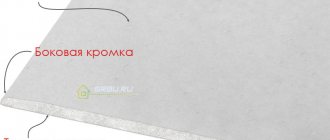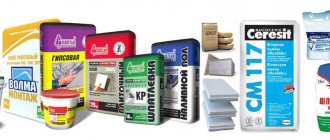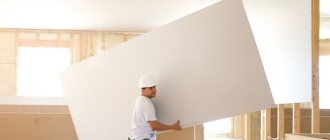Icer
17241 0 2
Icer July 12, 2017 Specialization: master in the construction of plasterboard structures, finishing work and laying floor coverings. Installation of door and window units, finishing of facades, installation of electrical, plumbing and heating - I can give detailed advice on all types of work.
Are you planning to sheathe the floor, walls or ceiling with gypsum fiber board, but don’t know how to correctly calculate the load on the structure? In this review, I will tell you all the information on this material so that you can carry out all the calculations yourself and understand all the features of the material.
In order to correctly make all the calculations, you need to know the dimensions and weight of the gypsum plasterboard sheet
Technical characteristics of gvl (gvlv) Knauf
Gypsum plasterboard supersheet has special properties that allow it to be used not only for covering walls, ceilings, but also for floors!
Thanks to a high-quality mixture of fiber and gypsum, as well as a special anti-chalking impregnation, supersheet can be used in buildings and premises for any purpose. The only fundamental difference in the use of gypsum board and moisture-resistant gypsum board is the possibility of installing the latter in places with high humidity. All main parameters of the sheets are given in Table 1. Table 1. Characteristics of gypsum fiber sheet
| Parameter | Meaning | Units |
| Dimensions | 2500x1200x10 2500x1200x12.5 | mm |
| Weight 1 sq.m. (sheet thickness 10 mm) | 10.8 | kg |
| Weight 1 sq.m. (sheet thickness 12.5 mm) | 15.62 | kg |
| Thermal conductivity | 0.22-0.36 | W/m °C |
| Parameter | Meaning | Units |
| Heat absorption | 6.2 | W/m °C |
| Bending strength | 5.3 | MPa |
| Brinell hardness | 20 | MPa |
| Humidity | 1.5 | % |
The moisture-resistant material differs from standard gypsum plasterboard in that its surface on both sides is treated with a special water-repellent agent. This allows it to be used in rooms with any degree of humidity.
If we talk about the properties of the materials, they are very similar. The dimensions and weight of moisture-resistant gypsum board are the same as those of a standard super sheet. The following characteristics are also identical: humidity, Brinell hardness, flexural strength and thermal conductivity gvl and gvlv. At the same time, the range of applications for moisture-resistant drywall is wider than standard, since even in the bathroom it will “stand idle” for its entire service life.
Weight hl. How much does a 12-12.5 mm drywall sheet weigh?
The weight of a sheet of drywall directly depends on its thickness and properties.
According to its properties, it can be ordinary, moisture-resistant, fire-resistant or moisture-fire-resistant.
The weight of a sheet of drywall is calculated as the weight of one square meter multiplied by the number of square meters.
Here are the GOST data regarding the weight of a sheet with an area of one square meter:
regular and moisture resistant - no more than 1 kg. for every millimeter of thickness;
fire-resistant and moisture-fire-resistant - from 0.8 to 1.06 kg. per millimeter of thickness.
One of the most common types of plasterboard is wall plasterboard, its thickness is 12.5 millimeters.
One square meter of this weighs on average 9.5 kg. Therefore, a sheet with an area of 2.4 sq.m. will weigh 9.5*2.4=22.8 kg.
That is, the weight for all standard sheet sizes will be as follows:
- sheet area: 2.4 sq.m. Weight: 23kg;
- sheet area: 3 sq.m. Weight: 29 kg;
- sheet area: 3.6 sq.m. Weight: 35 kg.
How much does one sheet of 9.5 mm drywall weigh?
Plasterboard with a thickness of 9.5 mm is called ceiling plasterboard because, as you might guess, it is used for installing ceilings or various kinds of curved structures.
This type of product is not subject to any random external pressure, therefore, it is somewhat thinner than its wall counterpart, which makes slabs of this type much easier to fix under the ceiling.
But let's return to the issue of weight. One square meter of 9.5 mm thick drywall weighs on average 7.5 kg.
From here, as in the previous case, we consider the mass of all standard sheets:
- sheet area: 2.4 sq.m. Weight: 18kg;
- sheet area: 3 sq.m. Weight: 22 kg;
- sheet area: 3.6 sq.m. Weight: 27 kg.
As you can see, there is nothing complicated here.
In conclusion, I would like to say about the main advantages of the material described in the article.
Namely, it is environmentally friendly: gypsum does not contain any harmful substances for humans;
Fire resistance: drywall (even not fireproof) is very poorly susceptible to fire;
Easy installation: anyone who has installed drywall will confirm that this is not a difficult task at all.
That's all for us. Good luck with your construction!
Types of GVL for floors: main types of markings, what it means
Gypsum itself is a hygroscopic material, so it is not recommended to lay gypsum board slabs on the floor if the room is exposed to humidity. For rooms with constant high humidity levels, for example, for kitchens, bathrooms, bathrooms, swimming pools and saunas, it is better to purchase GVLV, that is, moisture-resistant boards
Externally, the sheets do not differ from each other, so it is important to pay attention to the markings
What is laminated chipboard: sheet sizes, areas of application, how to choose (read more)
To decorate the floor covering, special GVL floor elements are produced, marked “EP”. Most often, the material is produced, which is the main supplier of sheet products on the domestic market. All products are distinguished not only by high quality, but also by increased strength characteristics.
Some people prefer to lay ordinary gypsum fiber boards on the floor, but for this, not one, but two elements are taken, which are located offset relative to each other. This distance most often does not exceed 3-5 mm. If special GVL sheets are used for Knauf flooring, they are laid in one layer, because they have sufficient strength.
Products intended for flooring are produced with the “EP” marking.
In addition, products are classified according to the type of edge. If the sheets have a straight edge, they are marked “PC”. Slabs with seam edges are also available, which minimizes the visual perception of joints. The fold size usually varies in width from 2.8 to 3.2 mm, depth - 1.7-2.3 mm. It is appropriate to decorate the floor with one or another type of material, but due to the fact that the price of gypsum fiber board for a floor with folded edges is higher, many prefer to purchase sheets with a straight edge.
As already mentioned, the production process of slabs is regulated by GOST standards. Based on this, the following standard size options are distinguished:
- width, cm – 50, 100, 120;
- length, cm – 150, 200, 250, 270, 300;
- thickness, mm – 12.5, 15, 18, 19, 20.
It is not always possible to adhere to these indicators, so a deviation in width is possible, but no more than 3-4 mm. As for the length, the deviations here should not exceed 2-3 mm. In rare cases, if the slabs are long, this figure reaches 4 mm.
The thickness of GVL sheets can vary between 12.5-20 mm.
In order not to make a mistake when purchasing a material, you should know what this or that marking means, for example, GVL-PK 2000x1000x12.5. Here you can see that a conventional slab is presented, which does not have moisture-resistant qualities, and is distinguished by a straight edge. If the abbreviation “VGLV-FK” is indicated on the marking, this means that the board is moisture-resistant with a seam edge.
One of the key advantages of gypsum fiber sheets is their fire resistance. Even cellulose, which is added to the gypsum mixture, does not burn or ignite; in the event of a fire, the material does not contribute to the spread of fire, which is especially important, for example, in wooden houses. In addition, the stoves will not emit toxic substances when burning.
General installation principles
It is possible and necessary to use GVL on the floor, but you must strictly follow the recommendations. In general, gypsum fiber sheet does not have very high strength. The short cellulose fragments reinforce the plaster to some extent, but the material is still quite brittle. Properly laid, it can withstand heavy loads - up to 2 tons per square meter. But the key words are properly laid out.
In one layer, and can withstand serious loads
Requirements for the base and installation features
GVL can be laid on either a continuous or discontinuous base. When laying on a solid base, it must be perfectly level. Requirements for the base - a difference of no more than 2 mm per 2 meters of length. Manufacturers insist on this and, if possible, it is better not to violate this recommendation.
One of the application options
In practice, it has been found that small smooth irregularities - an area of several square centimeters, a few millimeters in depth - are still acceptable. Manufacturers do not recommend it, but in practice it has been proven that GVL behaves more or less normally. The sheet may bend, repeating the shape of the notch. If there is linoleum, art vinyl or other soft covering on top, all this threatens is the appearance of a slight unevenness. It is better not to leave even such recesses under parquet or laminate, as the locks may come apart and there may be an unpleasant squeak.
And, even under a soft coating, unevenness cannot be left everywhere. If they are located where the load is applied, it is better to eliminate them. For example, on the aisle or where there will be a table leg, chest of drawers, bed, closet. There shouldn't be any irregularities here.
Second point. When laying on a loose base or on logs, GVL is placed on the floor either with increased density (floor elements) or moisture-resistant in two layers. When laying in two layers, the sheets are cut so that the seams of one layer do not coincide with the seams of the other. This is fundamental and the recommendation should absolutely not be violated.
The seams should not match
Third point. When laying GVL slabs on a hard, level floor (concrete), the ends are glued with PVA glue. When laying on a base that does not exclude movement (joists, for example), it is better to use elastic filler for the seams. One option is a sealant that remains flexible after drying. Apply it and immediately level the layer (you can use a gloved finger, for a better effect it can be moistened with water).
How to cut and fasten
You can cut gypsum fiber board with a hacksaw; for faster results, use an angle grinder (grinder) with a wood disc (ø 125 mm). In a straight line, you can break it just like drywall. To do this, cut one side (front) of the sheet, place a rule under the cut, tap the hanging part with your palm, and break it. The fracture site is far from perfectly level, so cutting gypsum fiber board onto the floor is hardly worth it. The cut has to be leveled and polished, and this takes no less time, and sometimes more, than working with a hacksaw.
Self-tapping screws for GVL need special ones - with a sharp conical head
The gypsum boards are secured to the floor with special self-tapping screws. They are called “by gypsum fiber”. They differ in that the cap has a sharper cone. This shape of the cap allows it to fit into a dense sheet without pre-drilling. The length of the screw must be at least 3 times the thickness of the slab. That's how you choose.
Subtleties of work
The uniqueness of GVL lies in the fact that they can be laid on almost any floor, including wood. In this case, it is necessary to take into account several features of the material laying technology. This is relevant if special requirements are imposed on the thermal insulation of the room. This is where additional material (for example, polystyrene) will come to the rescue. It should be noted that the height of the floor in this case will increase significantly.
It is not recommended to use materials of increased thickness: sheets 10 mm thick are suitable. A trademark dry screed allows you to hide all engineering systems, which is completely impossible with a traditional screed. Anyone who has at least once dealt with a dry screed from a well-known manufacturer is unlikely to want to fill the floor with concrete. Even a teenager can handle laying Knauf gypsum fiber boards. The process will not take much time and effort, the room will soon be ready for further work.
GVL on a concrete base
Concrete screed is a reliable foundation, but cold. If you don't heat it, the floor will be very cold. Residents of the first floors of high-rise buildings and private houses know this. The problem is solved by using a floating floor with improved thermal insulation characteristics. There is a traditional solution: put a layer of insulation and pour another layer of screed on top. But this is too heavy and will take a lot of time. You can make a dry screed - it's faster, easier and cheaper.
Comparison of sound insulation characteristics of various materials
How to make a dry GVL screed on a concrete base? A layer of insulation is placed on the concrete, and sheet material is placed on top. It is better to use polyurethane foam or high-density polystyrene foam (at least 35 kg/m³) as insulation. Why not mineral wool? Because its thermal insulation characteristics are several times lower. This means that instead of 3-5 cm of polyurethane foam, 15-20 cm of cotton wool will be required. Few people would want to raise the floor to such a height.
One of the sheet material options for dry floor screed is gypsum fiber boards. GVL is ideal for flooring, as it itself has increased heat-insulating properties and also dampens sounds well. GVL flooring is a good base for laminate, linoleum, carpet and other coverings.
Key points from the practical use of gypsum fiber board floors on concrete
When laying gypsum fiber board on a rigid base, it should lie tightly. There should be no voids or protrusions underneath. That is, the concrete base must be level and smooth. GVL is laid on concrete. Fasten along the perimeter in increments of 50-60 cm, install clamps. In general, you can use a composition like Rotband based on gypsum. It will both fill/even out minor unevenness and keep the sheets in place.
If it is necessary to improve the thermal insulation characteristics, extruded polystyrene foam (EPS) or polystyrene foam is placed on the concrete floor. You can simply lay it down without attaching it. But to prevent the insulation boards from creaking, they must lie tightly. If there are small irregularities, they can be filled with the same glue. It is applied under the slab using a notched trowel. The height of the tooth depends on the irregularities that need to be leveled.
Fasten two layers of gypsum fiber board together
The thickness of the foam is selected based on the requirements and structure of the cake. If there are two layers, they are laid with the seams staggered (so that the seams do not coincide). So that they do not rub or creak, or move out of place during operation, they can be fastened together. For this use:
- Tile adhesive. A thin layer is applied and trimmed with a notched trowel (4 mm). The glue is not for gluing, but for filling voids that are formed due to the fact that EPS is often in the form of a “boat”, that is, the edges are raised when compared to the middle.
- Mounting umbrellas. Such a length that only the foam sheets will stick. The floor should remain floating. There should be no fixation to the base.
- Double sided tape.
- Tie the layers with polyurethane foam. A good option that allows you to level out the imperfection of the EPS geometry. But the foam must be applied in a very small layer and it must have a slight expansion.
For floors, two layers of GVL are usually used. They are laid with seams spaced apart. The layers are fastened with self-tapping screws. The thickness of the gypsum plasterboard for the floor depends on the planned load. Typically, slabs of at least 12.5 mm thickness are used. If the geometry of the material is not ideal and there are differences in height, so as not to sand, you can use the same gypsum-based glue.
Areas of application of gypsum plasterboard and gypsum board
Despite the fact that GVL has higher strength characteristics. It cannot completely replace drywall. Simple material is used to level and create walls and partitions. The simplest partition includes a lattice frame made of vertical beams.
Installation of sheets on the floor
Use for partitions and walls
GCR wall cladding is often used, since this material is light in weight and does not create significant loads on the surface of the walls. Drywall is suitable for installing interior partitions and cladding frame buildings.
GVL for walls have high strength, which allows them to be used for cladding industrial premises. Reliable sheets are also relevant for installation in gyms. They cannot be used to process complex surfaces, but they have a long service life.
Installation method for partitions
The construction of gypsum plasterboard partitions is determined by the optimal weight of such material. You can create lightweight screens for zoning, which can be easily dismantled if necessary. This material can be used to decorate walls in residential areas: children’s rooms, bedrooms, living rooms and corridors. When performing renovations with a high level of humidity: kitchen, bathroom or veranda, GVL is recommended.
Partitions with insulation
To decorate the walls of a boiler room, switchboard or other structures with rising temperatures, it is better to use fire-resistant gypsum board. This material is also suitable for decorative cladding of fireplaces and stoves. To line a smoke duct in an unheated attic, you can use GKLVO.
Features and secrets of installing gypsum boards on the wall can be seen in the following video:
Watch this playlist on YouTube
Application for ceiling
The technology for installing gypsum plasterboard on the ceiling differs little from installing gypsum fiber board sheets. But there are also some peculiarities. GVL slabs are heavy, so they are difficult to mount to the ceiling alone. Self-tapping screws are used as fastening elements.
When installing a gypsum fiber board ceiling, you need to cut the material. A hand-held circular saw or jigsaw is used. All slab joints must be treated with gypsum putty.
When installing a suspended ceiling from gypsum plasterboard, you can get the following advantages:
- the ability to create complex configurations;
- formation of beautiful arches;
- application of any facing materials.
When installing a suspended ceiling in a bathroom, you need to choose a material with water-repellent characteristics.
Interior use
The use of gypsum fiber on the floor is especially important. In this case, panels are used to withstand high humidity. Since the material has a minimal coefficient of expansion, the joining seams will remain sealed. Interior finishing using gypsum fiber boards allows you to reduce the period of finishing work. GVL sheets can be mounted on frames made of wood or metal. This results in a perfectly flat surface that is suitable for painting, wallpapering and tiling.
Drywall is used to create a convenient TV shelf and functional niches
A device made of gypsum plasterboard for window and door slopes is often used. Installation is carried out before finishing is done. Drywall can be glued to plaster. On door and window openings, the material must be glued over the entire surface, and not in fragments. The designs of arched openings made from gypsum plasterboard are wonderful and beautiful.
Weight of plasterboard ceiling. Pros and cons of ceiling plasterboards
To be precise, the industry does not formally produce gypsum sheets specifically for plasterboard cladding of floors. Simply, from a fairly wide range of gypsum boards, sheet material is selected that is best suited for ceiling decoration.
Most experts classify primarily lightweight grades of plasterboard that meet at least two requirements as ceiling plasterboards:
- Small thickness of sheet cladding. On average, the thickness of plasterboard for the ceiling is 6-9 mm. All other brands are usually classified as wall and frame products;
- A special shape of the end edge, which simplifies the sealing of seams in an inconvenient ceiling position of the cladding.
It cannot be said that the thinnest sheets of plasterboard are used for ceiling cladding, although most customers, without hesitation, choose a thickness of 6-8 mm, believing that this approach reduces the load on the frame or rough lining of the floor.
Edge design options
Important! The thickness of the gypsum plasterboard for the ceiling is not selected arbitrarily, but based on data about the nature of the room, the design features of the ceiling frame or sheathing and the size of the ceiling.
The advantages of the material include higher density and rigidity of the material. If a complex configuration is being built on the floor, then the use of a thin arched plasterboard sheet significantly simplifies the assembly and smoothing of curved surfaces.
The disadvantages of plasterboard cladding include an increased tendency to cracks. The small thickness of the ceiling plasterboard forces you to limit the size of one section, otherwise it becomes simply impossible to lift and install a large sheet. In addition, even with a relatively small size of ceiling plasterboard of 120x250 cm, bringing and lifting the material into the apartment along the flights of stairs becomes a real challenge.
Classification and technical characteristics. Marking
GLV slabs are divided into standard (GLV) and moisture-resistant (GVLV).
The former are well suited for interior decoration of industrial and residential premises, in which there is a normal temperature regime and fairly dry air.
Moisture-resistant sheets are treated with a hydrophobic solution, thanks to which they can be effectively used in all wet rooms (kitchen, toilet, bathroom), as well as in attics, basements, garages and many other construction sites.
Both standard and moisture-resistant gypsum boards have a rectangular shape.
They can be with direct (PC)
And folded (FC) edges.
Marking
The marking is applied to the back of each gypsum fiber sheet and looks like this:
- The sheet type (GVL/GVLV) is indicated first.
- The group of type and manufacturing accuracy (A/B) is indicated
- Edge type (see above). PC or FC.
- Dimensions.
- Standard
An important issue regarding the safety of using the material
Some sources contain information that GVL sheets are harmful and dangerous to the health of others, therefore they are categorically not recommended for use in premises for children and even for interior work in general. Similar information can be found about other slab products from different manufacturers.
Gypsum fiber is considered an absolutely safe material
The vast majority of experts categorically do not support such a statement. To understand whether a material is harmful, you should first pay attention to the manufacturing features, as well as the substances used.
As noted earlier, the main components of the material are gypsum and cellulose fiber, which are bonded together using a bonding element. In this case, this component is harmless latex, which additionally makes the material moisture resistant. Thus, it becomes clear that even with great heating, for example, in a fire, the material will not release toxic substances. Accordingly, there is no likelihood of vapor poisoning.
Fact! GVL sheets, unlike other types of floors, are able to withstand high temperatures for 1.5 hours, while the panels do not change their structure.
Technology for laying gypsum fiber moisture-resistant sheets
If the room is equipped with a good ventilation system, then the sheet (weight from 40 to 42 kg) is even laid on a concrete screed. For this, experts recommend choosing medium-sized slabs.
A sheet weighing 40 kg is suitable for laying on a wooden or reinforced concrete surface.
Follow the procedure for laying gypsum fiber moisture resistant sheets
Laying is carried out according to the following scheme:
- The floor is thoroughly cleaned of debris and dust. If there are cracks or similar defects, they are repaired.
- Polyethylene is laid, which protects the laid floor from moisture.
- The edge tape, which acts as a sound absorber, is laid out around the perimeter of the room. Columns and similar interior parts adjacent to the floor are covered with tape.
- Altitude beacons are set along which the guides will be placed.
- The guides themselves are laid and leveled - they will allow you to accurately level the insulation layer.
- Expanded clay is poured. It is compacted and leveled along pre-installed guides.
- Next, GVLV (whose weight does not exceed 40 kg) is laid starting from the corners of the room. After the first slabs are laid, they are fixed with an adhesive solution or mastic. Another layer of slabs is placed on top, the weight of which does not exceed 40 kg.
- The layers are connected to each other using screws.
- When the main installation work is completed, the floor is primed and the outer covering is installed.
GVLV sheet
(weight - from 39 to 43 kg) is a new product in the field of repair, which is designed as an alternative to drywall, but without its weaknesses. Reinforcement with fluff pulp increases the technical characteristics of the material and makes its use for flooring or wall cladding more preferable.
What determines the thickness of the sheet?
The choice of parameters for a gypsum board sheet is very important, as it reduces the amount of material used and allows you to save money. Thickness occupies a special place, because strength depends on it.
Drywall is designed for “dry” work, when the sheet and frame are the basis of the structure. It is made by pressing a gypsum mixture between two sheets of cardboard. Special substances are added to the core, which give the sheet the required characteristics depending on its purpose.
The main parameter that will be affected in the future by the selected thickness of drywall is, of course, strength. When choosing a material, think about what loads the future structure will be designed for.
For partitions, it is important to choose the right type of plasterboard construction: single-layer, double-layer or facing. The range also includes claddings with fastening to the base wall.
Another important parameter on which the choice of sheet thickness depends is its installation. For sheets with a standard thickness, standards are established for the distance between the locations of the metal frame profiles on which the drywall is attached. If you ignore these standards and choose a material with low-quality racks, and drywall with a small thickness, then the design will not be reliable at all.
Dry screed with GVL sheets
This technique was developed by Knauf, and a high-density tongue-and-groove gypsum board was developed for it. This material is called Super Floor. The essence of the method is that fine expanded clay (expanded clay sand) is poured onto a base (any, of any degree of curvature). Expanded clay is leveled, and floor elements made of gypsum fiber board are placed on it. The finishing floor covering can be laid on this base. You can make your own insulated floor very quickly and conveniently. In addition, the technique does not create significant loads on the floor.
GVL on the floor: dry screed
Instead of expanded clay sand, you can use regular construction dry sand. You cannot mix different materials or different fractions, as sooner or later they will shrink. And when laying gypsum fiber board on the floor, a flat base without dips is required. So it’s better not to allow drawdowns.
https://youtube.com/watch?v=JowehhYjIT4
Application for floor
After installing the gypsum fiber board on the walls, you can begin finishing the floor.
Stages of work:
- The floor level is marked.
- Vapor barrier is installed.
- Foam edging tape is glued along the walls.
- Expanded clay backfill is laid on the prepared base and leveled.
- The subfloor is assembled from gypsum fiber elements, the seams are coated with glue, the elements are fastened with self-tapping screws through the folds.
- The joints are puttied.
- After this, finishing material – tiles or linoleum – can be laid on the GVL.
The manufacturer recommends that if a thin elastic coating is used, pour a leveling mixture over the gypsum fiber coating with a layer of 2 mm or more.
It is impossible to make a complex curved design structure from a gypsum fiber sheet. But you can be sure that it will not break during installation and during operation.
Now you know what GVL is and how to install it. Reviews from craftsmen indicate that this is a reliable material for finishing walls in apartments. GOST assumes the absence of toxic substances harmful to humans, so you don’t have to worry about your health. The only significant drawback is the heavy weight.
GVL for walls
In this case, there are two ways to mount sheets to the wall.
Frameless method
With this method, GVL sheets are attached to the walls using special glue. The type of adhesive and quantity will depend on the unevenness of the walls. If the defects on the wall are small, gypsum glue is applied to the sheets and pressed to the surface. If the unevenness on the wall is significant, then it is worth applying a special strong glue around the perimeter of the sheet, and then in the middle, dotted every 30 cm. If in the future you plan to hang any cargo in the form of shelves or hangers on the gypsum board, you need to coat the entire surface of the sheet with glue for greater reliability.
Frame method
For this method, you first need to make an iron frame that can withstand heavy loads. You can also place additional insulation or sound insulation under the frame, and you can also hide electrical wiring and other communications there. The gypsum fiber sheets themselves must be attached to the frame using special self-tapping screws with double-row threads.
Conclusion
Now you can easily calculate the weight of the sheets you will use. The video in this article will help you understand even better the individual nuances of the topic discussed, and if you don’t understand anything, then ask questions in the comments.
Did you like the article? Subscribe to our Yandex.Zen channel
July 12, 2022
Plasterboard systems
If you want to express gratitude, add a clarification or objection, or ask the author something, add a comment or say thank you!
Main characteristics of moisture-resistant gypsum fiber sheet (gvlv)
The very concept of “plasterboard” is quite broad, since it includes several types of this material. They differ significantly in operating conditions, and, accordingly, in their composition. In addition, there is such a thing as a “fiber supersheet”. Such material has a number of advantages compared to gypsum board and, according to the Knauf classification, is divided into:
- superlist (gvl),
- moisture-resistant supersheet (gvlv),
- small format supersheet.
Each of the above options is characterized by increased mechanical strength, excellent sound insulation, fire resistance and has a special fibrous structure. The latter property allows you to carefully cut drywall and process edges without much effort.
Technical characteristics of gvl (gvlv)
Gypsum plasterboard supersheet has special properties that allow it to be used not only for covering walls, ceilings, but also for floors! Thanks to a high-quality mixture of fiber and gypsum, as well as a special anti-chalking impregnation, supersheet can be used in buildings and premises for any purpose. The only fundamental difference in the use of gypsum board and moisture-resistant gypsum board is the possibility of installing the latter in places with high humidity. All main parameters of the sheets are given in Table 1.
Table 1. Characteristics of gvl supersheet (gvlv)
The moisture-resistant material differs from standard gypsum plasterboard in that its surface on both sides is treated with a special water-repellent agent. This allows it to be used in rooms with any degree of humidity.
If we talk about the properties of the materials, they are very similar. The dimensions and weight of moisture-resistant gypsum board are the same as those of a standard super sheet. The following characteristics are also identical: humidity, Brinell hardness, flexural strength and thermal conductivity gvl and gvlv. At the same time, the range of applications for moisture-resistant drywall is wider than standard, since even in the bathroom it will “stand idle” for its entire service life.
Advantages and application of moisture-resistant supersheet
Fibrous gypsum board has all the advantages of conventional drywall:
- environmental friendliness,
- high heat and sound insulation,
- non-flammability,
- mechanical strength and abrasion resistance,
- ease of installation.
It has only two drawbacks: price and significant weight of the gvl (gvlv) sheet. The first problem can be solved by minimizing waste, and the second can be solved by using a good assistant during the installation process.
Moisture-resistant plasterboard can be used in almost any type of building. Main use cases:
- in places with a high fire hazard as wall and ceiling cladding,
- for cladding attics, balconies and basements (if ventilation is available),
- for the construction of partitions in apartments with high humidity (for example, in bathrooms),
- for unheated rooms,
- for prefabricated floor subfloors.
In the bathroom, it is recommended to additionally treat the surface of the wall made of glvv from Knauf with special moisture-resistant decorative coatings (paint) or cover it with ceramic tiles.
Installation of gvlv on the floor
The slabs can be laid on almost any base: reinforced concrete or wood. For these purposes, the best option would be to use a 12 mm thick gypsum board sheet. The order of work will be as follows:
- Attaching a special edge tape.
- Filling with expanded clay or installing insulation.
- Laying a standard size gypsum board (gvlv) sheet on the floor.
- Treat the surface of the first layer with glue or mastic.
- Installation of the second layer.
- Tightening the layers with screws.
- Primer.
- Installation of covering (most often linoleum).
If you need to install bathroom floors, you should definitely treat the joints with waterproofing tape. This will help avoid moisture ingress and protect the structure from premature destruction.
Of course, gvlv is a “new word” in the development of the construction business. It is especially convenient to use this material during DIY repairs, as it is very easy to process. Moreover, the market offers gypsum board sheets of various thicknesses and sizes, which significantly optimizes marking and installation work.
The only important point is that you should not purchase materials from dubious manufacturers whose reputation on the market is not confirmed by real documents. After all, compliance with GOST sheets gvl and gvlv is the main guarantee of the quality and safety of the entire structure. Nobody wants to redo most of it a couple of tapes after the repair. I would like to hear the opinion of experienced drywall craftsmen on how to avoid the most common mistakes.
How to putty GVL Knauf.
KNAUF-Fugen putty has a specially selected composition, so adding additional components will change the properties of the material. You cannot use a thickened solution, just as you cannot dilute it with water - this will not restore the putty’s original properties. The performance characteristics of the solution are maintained for at least 30 minutes. During work, it is necessary to use only clean tools and mixing containers, otherwise the working properties of the material may deteriorate.
Preparation of putty solution. The KNAUF-Fugen mixture is poured into a clean container with cold water. The most convenient for mixing and working when puttingtying joints will be a special stainless steel box (ditch) and a trowel with a blade 80 mm wide, matching the size of the bottom of the trough. Pour KNAUF-Fugen in small portions into a cuvette with water until non-wetting islands appear. Next, wait 2-3 minutes (the interaction of the dry mixture with water) and begin kneading until it reaches a creamy consistency.
Mixing proportion: 1 kg of dry mixture per 0.8 l. water. We also expect the material to “swell” and stir the resulting solution with a spatula. Bring the solution until a homogeneous mixture without lumps is formed and determine the quality visually. It is not recommended to stir the joint sealing compound with a mixer as air will be forced into the solution, bubbles may appear and the working time of the solution will be sharply reduced.
Large volumes of KNAUF-Fugen, for example, when installing KNAUF-gypsum boards or continuous puttying, can be stirred with a mixer. At the same time, to prevent the formation of air bubbles, the equipment should operate at low speeds, not higher than 300 rpm. Otherwise, the strength of the hardened putty layer will be reduced. Be sure to control the water temperature - the material must be diluted in water with a temperature of 5 to 30°C. Hotter water worsens the characteristics of the solution, leads to premature setting and increases its tendency to crack during the drying process.
The main advantages and disadvantages of gypsum fiber boards for flooring
Many people prefer to use gypsum fiber board for “warm floors” because the material has good thermal conductivity and does not retain heat. At the same time, the slabs are suitable for organizing water, electric and combined floors. In this case, sheets of any thickness are used, but experienced builders recommend taking products measuring 10-12 mm.
Note! In addition to the fact that the material is suitable for decorating horizontal and vertical surfaces, it is also successfully used in arranging window and door openings, for creating decorative boxes that help hide utility lines, as well as for decorating partitions and false walls in technical and residential premises. . Gypsum fiber is suitable for leveling all types of floors. The main advantages of gypsum fiber boards:
The main advantages of gypsum fiber boards:
- Quick installation. A floor leveled with sheets can be immediately covered with finishing materials, and it is also possible to install any heating system.
- Easy transportation. Due to the fact that the flooring sheets are generally characterized by small dimensions, there will be no difficulties with transporting and lifting the slabs.
- Light weight. This allows the sheets to be laid on bases that are not particularly durable. For example, you can lay gypsum fiber sheets for the floor on wooden beams.
- Possibility of use in unheated rooms. Due to the fact that materials with a high moisture content are not used during installation, it is permissible to install the panels even in rooms with temperatures below zero.
- No debris during installation. When cutting, the sheets do not crumble or crack, as happens with plasterboard; as a result, there will be a minimum amount of waste during operation.
- Good performance characteristics. Unlike traditional flooring materials such as chipboard or fiberboard, after installation there is no likelihood of squeaks due to displacement and friction of the boards. With constant temperature fluctuations, the sheets do not change shape.
- Ability to withstand mechanical shocks. Even with a pinpoint impact, most likely, just dents will appear, but not cracks.
- High fire resistance. GVL belongs to the group of materials G-1, which according to the classification means low-flammability. In case of fire, the sheets retain their original shape for a long time, and when heated they do not emit harmful substances.
- Safety for others. The composition contains components of natural origin, so laying the slabs is allowed in premises of any purpose.
GVL sheets are suitable for use in both heated and unheated rooms.
The disadvantages of using gypsum fiber sheets for flooring include the following:
- Rough handling or improper cutting can break or damage the slab;
- the price of gypsum fiber sheets for flooring is higher than the cost of other rough coatings;
- many note that even moisture-resistant material is exposed to fungus and rot.
Features of working with moisture-resistant drywall
GVL is suitable for work in rooms with aggressive environments:
- kitchens;
- bathrooms;
- showers;
- swimming pools.
The joints and edges of the panels are treated with moisture-proof compounds. Impregnation is carried out before finishing so that moisture does not get inside the material.
Frame making
Installation work begins with the manufacture of a frame, for which metal profiles are used.
Let's look at the GVL sheet and what it is for the kitchen and bathroom. Knauf offers decor and design options that are specially designed for wet use. Complete Knauf Dry Construction systems for interior finishing are recognized as advanced.
